Research from a UK insurance company that provides vehicles with black box, telematics technology throws a light on what causes crashes. According to the firm, Insure The Box, its analysis of around 5 billion km of driving data provides a crucial insight. The telematics pioneer uses black box data to target regular speeding culprits and provides safer driving support.
According to the firm’s data analysis, drivers who speed more than 20% of the time increase their risk of having an accident by 87%. Meanw
November 3, 2016
Read time: 2 mins
Research from a UK insurance company that provides vehicles with black box, telematics technology throws a light on what causes crashes. According to the firm, Insure The Box, its analysis of around 5 billion km of driving data provides a crucial insight. The telematics pioneer uses black box data to target regular speeding culprits and provides safer driving support.
According to the firm’s data analysis, drivers who speed more than 20% of the time increase their risk of having an accident by 87%. Meanwhile those that speed 10% of the time increase the risk by 42%. However, the firm claims that targeted communications can reduce speeding by 15%.
Smoothness of driving is also a key factor in the risk of crashes as the analysis from reveals. Drivers who exhibit erratic driving behaviour such as swerving, speeding and habitually slamming on the brakes are far more likely to end up having a crash.
The firm also recently identified a 30% increase in evening rush hour accidents immediately after the clock change and implemented a programme of communication to warn customers about the risks.
Charlotte Halkett, general manager communications for Insure The Box said, “Unlike traditional motor insurers, we can calculate the risk of a customer having an accident based on their individual driving patterns, rather than the usual parameters such as age and vehicle engine size. And the actual driving data received from the black boxes installed in our customers’ vehicles enables us to directly target feedback and incentives to encourage our policyholders to improve their driving.”
The firm says that by fitting its telematics technology, drivers are far less likely to speed while the systems can also call for assistance in the event of an impact and help reduce the incidence of fraudulent insurance claims.
According to the firm’s data analysis, drivers who speed more than 20% of the time increase their risk of having an accident by 87%. Meanwhile those that speed 10% of the time increase the risk by 42%. However, the firm claims that targeted communications can reduce speeding by 15%.
Smoothness of driving is also a key factor in the risk of crashes as the analysis from reveals. Drivers who exhibit erratic driving behaviour such as swerving, speeding and habitually slamming on the brakes are far more likely to end up having a crash.
The firm also recently identified a 30% increase in evening rush hour accidents immediately after the clock change and implemented a programme of communication to warn customers about the risks.
Charlotte Halkett, general manager communications for Insure The Box said, “Unlike traditional motor insurers, we can calculate the risk of a customer having an accident based on their individual driving patterns, rather than the usual parameters such as age and vehicle engine size. And the actual driving data received from the black boxes installed in our customers’ vehicles enables us to directly target feedback and incentives to encourage our policyholders to improve their driving.”
The firm says that by fitting its telematics technology, drivers are far less likely to speed while the systems can also call for assistance in the event of an impact and help reduce the incidence of fraudulent insurance claims.








